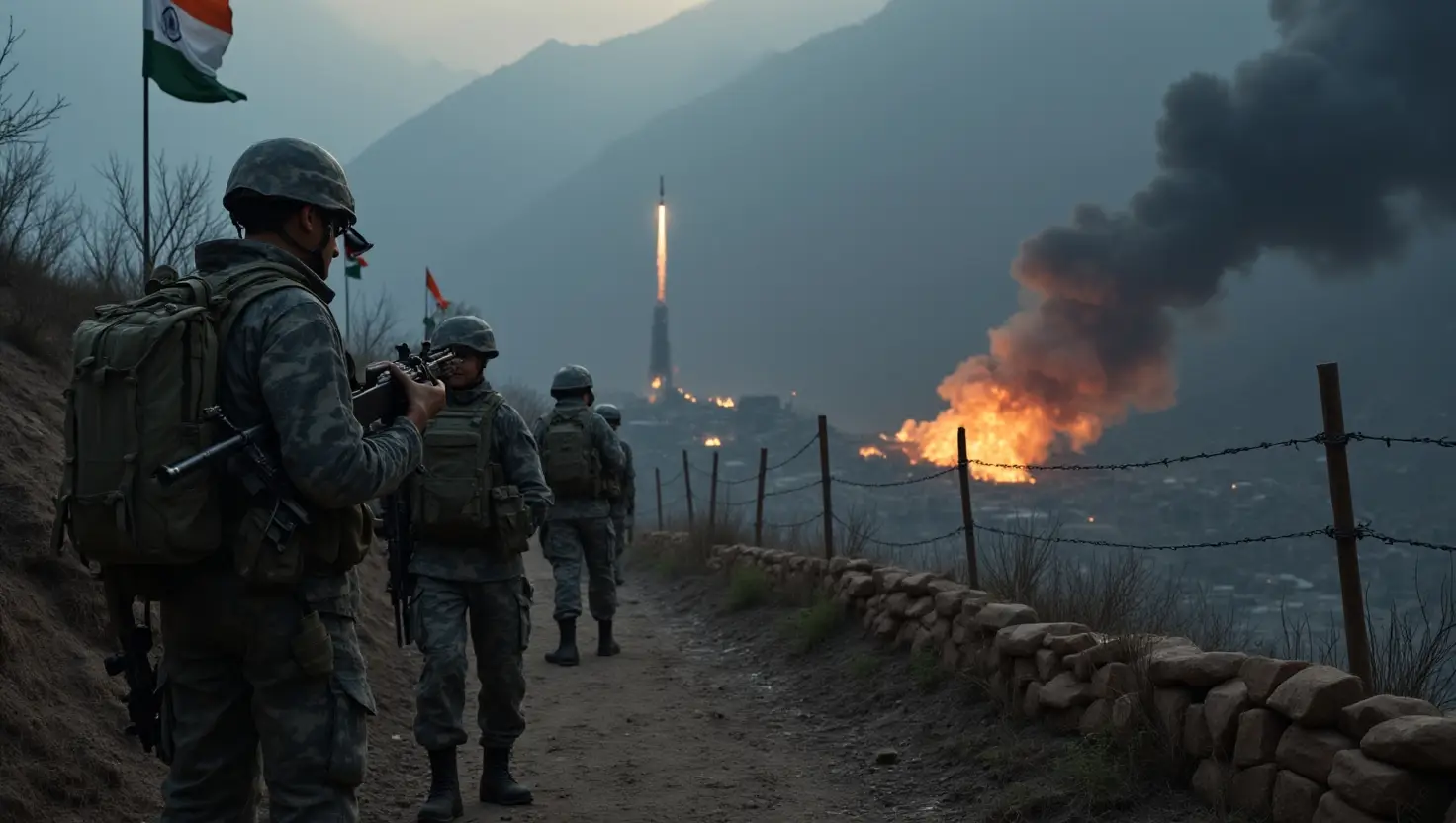On May 7, 2025, India Initiated Missile Strikes on Pakistan and Kashmir Escalating Regional Tensions
On May 7, 2025, India launched missile strikes on Pakistan and Pakistan-administered Kashmir under Operation Sindoor. India said the strikes targeted terrorist groups linked to a deadly April attack in Indian Kashmir, blaming Pakistan for supporting militants. The strikes reportedly avoided military bases but hit terrorist sites.
Pakistan reported civilian casualties and damage to mosques and homes. They claimed to have shot down Indian jets and captured soldiers in response. Pakistan’s leaders condemned the strikes and took strong defensive measures including closing airspace and declaring an emergency.
The international community has called for calm and dialogue to avoid further conflict. This event echoes past India-Pakistan tensions and raises concerns about security in the region.
Key Takeways
- India targeted terrorist infrastructure in Pakistan following an attack on civilians.
- Pakistan reported civilian deaths and responded with counterattacks and military actions.
- Global leaders urged restraint to prevent escalation between the two countries.
Overview of Operation Sindoor
Operation Sindoor involved targeted missile strikes carried out by India against locations in Pakistan and Pakistan-administered Kashmir. The operation aimed at specific militant targets linked to a recent attack, with carefully planned timing and military actions explained by Indian authorities.
Objectives and Scope
The primary aim of Operation Sindoor was to destroy terrorist infrastructure related to the April 22 Pahalgam attack. This attack had killed 26 civilians, mostly Hindu tourists. India identified The Resistance Front, connected to Lashkar-e-Taiba, as responsible for the Pahalgam attack.
The operation focused solely on militant bases and avoided Pakistani military sites. Its goal was to weaken terrorist networks without escalating full-scale conflict. The strikes were limited to missile launches and did not involve crossing into Pakistani airspace by Indian aircraft.
Timeline of Events
The strikes were launched on May 7, 2025, in a coordinated series of missile attacks during the early hours. India targeted multiple sites identified as terrorist hubs within Pakistan and Pakistan-administered Kashmir.
Pakistan responded quickly, reporting civilian casualties and damage to mosques and residential areas. Pakistan then claimed a strong military response, including shooting down Indian jets and capturing soldiers. The sequence of events escalated rapidly within hours after the missile strikes.
Indian Government’s Stated Rationale
India described Operation Sindoor as a “focused, measured, and non-escalatory” action. The government stressed it was a precise strike against terrorist infrastructure and did not intend to broaden the conflict with Pakistan.
Officials emphasized the strike was in direct response to the Pahalgam attack and aimed to protect Indian citizens from future terrorist threats. They also highlighted that Indian aircraft did not violate Pakistani airspace, aligning the operation with India’s claims of restraint.
Background to the Crisis
The recent conflict traces back to a deadly attack in the Kashmir region, attributed to a specific militant group. This section explains the event, the groups involved, and the long history of dispute between India and Pakistan that frames the current tensions.
April 22 Pahalgam Attack
On April 22, 2025, a deadly attack occurred in Pahalgam, Indian-administered Kashmir. Militants targeted a group of mostly Hindu tourists, killing 26 civilians. The assault caused national outrage in India.
The attack took place in a popular tourist spot. It highlighted ongoing security concerns in the region. Indian officials immediately linked the attackers to a militant group based in Pakistan.
This violent incident increased pressure on India to respond. The government used the attack to justify its later military actions against Pakistan-related targets.
The Resistance Front and Lashkar-e-Taiba
The Resistance Front (TRF) is the group India accused of carrying out the Pahalgam attack. TRF is said to be a front for Lashkar-e-Taiba (LeT), a Pakistan-based militant organization.
LeT has a long history of involvement in Kashmir conflicts. It is considered a terrorist group by many countries, including India and the US. LeT supports violent actions against Indian forces and civilians in Kashmir.
TRF operates covertly but is believed to direct militants on the ground. India holds Pakistan responsible for harboring and supporting these groups, a claim Pakistan denies.
Historical Context of India-Pakistan Tensions
India and Pakistan have fought multiple wars since their independence in 1947, mostly over Kashmir. The region remains disputed, with both countries claiming it fully.
There have been repeated incidents of violence and cross-border attacks. The two nuclear-armed neighbors maintain large military presences along the Line of Control.
Previous flare-ups, such as the 2019 conflict after the Pulwama attack, show the risk of rapid escalation. Diplomatic efforts have often failed, keeping the situation tense and fragile.
Details of the Missile Strikes
India launched multiple missile strikes targeting specific sites linked to militant activity. These strikes mainly occurred in Pakistan and Pakistan-administered Kashmir. The impact on civilians, claims about the nature of the targets, and the technology used in the strikes have been notable aspects in reports so far.
Targets and Locations in Pakistan and Pakistan-Administered Kashmir
India said the strikes focused on terrorist infrastructure connected to the April 22 attack in Pahalgam. Sites targeted included weapons storage, training camps, and safe houses. Locations given included areas near Muzaffarabad in Pakistan-administered Kashmir and several sites across northern Pakistan.
Pakistan stated that missile strikes hit residential neighborhoods and mosques as well as some military sites. Pakistani officials listed cities like Mirpur and Rawalpindi among the affected areas. Both sides differ sharply on which locations were targeted and the nature of those sites.
Civilian Impacts and Casualties
Pakistan reported at least nine civilians killed, including a child, with 38 more wounded by the missile strikes. Injuries occurred in homes, markets, and religious places. Pakistani sources emphasized civilian damage to highlight the humanitarian toll.
India disputed civilian casualty claims, stating the strikes were precise and aimed at militant groups without hitting residential zones. However, independent verification of casualties and damage remains limited due to restricted access.
Claims of Avoiding Military Facilities
India insisted the strikes avoided Pakistani military bases and infrastructure. The Indian government emphasized that no Indian aircraft entered Pakistani airspace, using missile technology instead to limit escalation.
Pakistan contradicted this by claiming damage to an Indian brigade headquarters and reported shooting down fighter jets involved in retaliatory actions. These conflicting claims form a core part of both countries’ narratives.
Technical Aspects of the Strikes
India reportedly used surface-to-surface ballistic missiles launched from Indian-administered Kashmir. These missiles were said to have high accuracy and moderate range, designed to hit fixed ground targets while minimizing collateral damage.
Pakistan claimed to have intercepted several missiles and downed drones. Information on the exact missile types and interception systems involved is limited. Both nations cited modern military technology to justify their capabilities and claims of precision.
Political and Diplomatic Reactions
Prime Minister Shehbaz Sharif condemned the Indian strikes as an “unprovoked and blatant act of war.” He vowed a strong and decisive response to protect Pakistan’s sovereignty.
Pakistani officials appealed to the international community to intervene and called for immediate de-escalation. The government reported plans to raise the issue at forums like the United Nations.
Diplomatic efforts focus on highlighting India’s role in fueling unrest and seeking global support against what Pakistan calls aggressive military action.
Closure of Airspace and State of Emergency
In response to the escalating conflict, Pakistan closed its entire airspace to civilian traffic. This move aimed to prevent further aerial incidents and protect commercial flights.
Authorities also declared a state of emergency in key parts of the country. Security forces received orders to increase vigilance and prepare for any further attacks.
Travel and public activities faced stricter controls in affected regions. The government urged citizens to stay alert and cooperate with security measures to maintain order.
Reactions from the International Community
The international response to the conflict between India and Pakistan has focused on urging both sides to avoid further violence and seek diplomatic solutions. Several global powers expressed concern over the risk of escalation between two nuclear-armed states. Many stressed the importance of dialogue to ease tensions and prevent more casualties.
United Nations Statements
The United Nations called for immediate restraint from both India and Pakistan. It expressed grave concern about the strikes and counterstrikes in the Kashmir region. The UN Secretary-General emphasized the need to protect civilians and uphold international law.
The UN also urged both countries to enter talks without delay. It highlighted the risk that continued conflict might destabilize wider regional peace. The Security Council held emergency consultations but did not issue a formal resolution at the time.
United States Position
The United States officially condemned the violence and called for calm. It urged India and Pakistan to avoid any actions that could escalate conflict further. The US stressed the importance of diplomacy and peaceful dialogue to resolve underlying issues.
Washington also expressed support for maintaining stability in South Asia. It remained committed to working with both countries to reduce tensions. US officials emphasized that military action risked dangerous consequences for the broader region, including global security concerns.
Other Countries’ Responses
Several other nations, including China, Russia, and members of the European Union, expressed concern over the rising tensions.
- China called for restraint and emphasized the need to respect each country’s sovereignty.
- Russia urged both sides to engage in peaceful dialogue and avoid military confrontation.
- European Union leaders highlighted the importance of stability in South Asia and condemned violence affecting civilians.
Many neighboring countries anxiously watched the developments, fearing regional instability. Some offered to mediate talks to ease the conflict.
Calls for Dialogue and Restraint
International organizations and diplomats consistently urged India and Pakistan to resume peace talks. They stressed that lasting solutions must come through negotiations, not military force.
Multiple statements emphasized protecting civilians and avoiding attacks on non-military targets. Humanitarian agencies voiced alarms over risks to vulnerable populations in Kashmir.
Countries and groups called on both governments to respect ceasefires and find diplomatic pathways. These calls aimed to prevent any further loss of life and reduce the risk of full-scale war.
Comparisons with Previous India-Pakistan Conflicts
The recent missile strikes by India and Pakistan’s response share clear similarities with past clashes. Both involve rapid retaliation and claims of targeting militants while avoiding full-scale war. These events also highlight long-standing issues in Kashmir that continue to fuel violence.
Parallels with 2019 Pulwama Crisis
The 2019 Pulwama crisis began with a suicide bombing that killed 40 Indian paramilitary personnel. India responded with airstrikes on what it said were militant camps in Pakistan.
The current strikes also followed an attack on civilians and were framed as precise hits on terrorist infrastructure. In both cases, Pakistan denied involvement and claimed India targeted civilians.
Both crises caused a surge in military activity but stopped short of full war. Each side claimed to have shot down enemy aircraft and captured soldiers. Political leaders on both sides condemned the other and took defensive measures like closing airspace.
Recurring Patterns in Kashmir
Violence in Kashmir often follows militant attacks on civilians or security forces. India launches targeted operations in response, citing threats from Pakistan-supported groups.
Pakistan routinely rejects these claims, asserting that Indian strikes harm civilians and violate sovereignty. This pattern mirrors decades of conflict in Kashmir, where both countries accuse each other of aggression.
Civilian casualties often increase tensions, while military actions escalate quickly but rarely result in sustained conflict. Both nations remain on alert, maintaining troop presence along the border and readiness for further incidents.
| Recurring Elements | Description |
|---|---|
| Trigger | Militant attack on civilians or forces |
| Indian Response | Targeted strikes on militant sites |
| Pakistani Reaction | Denial, claims of civilian harm |
| Military Escalation | Airspace closures, troop mobilization |
| Civilian Impact | Casualties, displacement |
Potential Implications for Regional Security
The recent missile strikes and counteractions have raised serious concerns about the security situation in South Asia. The risks include possible escalation between India and Pakistan, ongoing instability in Kashmir, and uncertain military and diplomatic futures.
Risk of Escalation Between Nuclear-Armed States
India and Pakistan both possess nuclear weapons, making any conflict highly dangerous. The missile strikes and Pakistani responses could trigger quicker, more aggressive military actions.
Both countries have shown willingness to engage in direct attacks, which raises the chance of miscalculation or accidental escalation. This increases the risk of a larger, potentially nuclear conflict.
International calls for restraint highlight global fears. However, the current tension underscores how fragile peace is when two nuclear powers clash over the Kashmir dispute.
Impact on Kashmir’s Stability
Kashmir remains a highly unstable region due to the ongoing conflict between India and Pakistan. The missile strikes have worsened the security environment, affecting civilians on both sides.
The targeting of terrorist infrastructure and civilian areas has led to casualties and heightened fear among local populations. This can fuel further unrest and recruitment for militant groups.
The increased military activity makes it difficult to maintain order or pursue peace efforts. Kashmir’s future stability is closely tied to how India and Pakistan manage their conflict and civilian safety.
Future Military and Diplomatic Prospects
Both countries have strengthened their military postures in response to the recent strikes. Pakistan’s closure of airspace and declaration of emergencies signal readiness for further conflict.
Diplomatically, international pressure encourages dialogue, but trust is low. Past peace talks have failed due to incidents like these, complicating future negotiations.
Any upcoming talks will likely focus on preventing escalation but face challenges due to mutual accusations and hardened stances after these events. The path forward remains uncertain.
| India | Pakistan |
|---|---|
| Many support the government’s response. | Many condemn the Indian strikes. |
| Calls for stronger action against militants. | Strong demand for government to respond firmly. |
| Sympathy for victims of the Pahalgam attack. | Sympathy for civilians affected by missile strikes. |
Social media platforms have seen heated debates and a surge in nationalist sentiments on both sides. False information and rumors have also spread, complicating the public’s understanding of events.











3 thoughts on “India Initiated Missile Strikes on Pakistan”